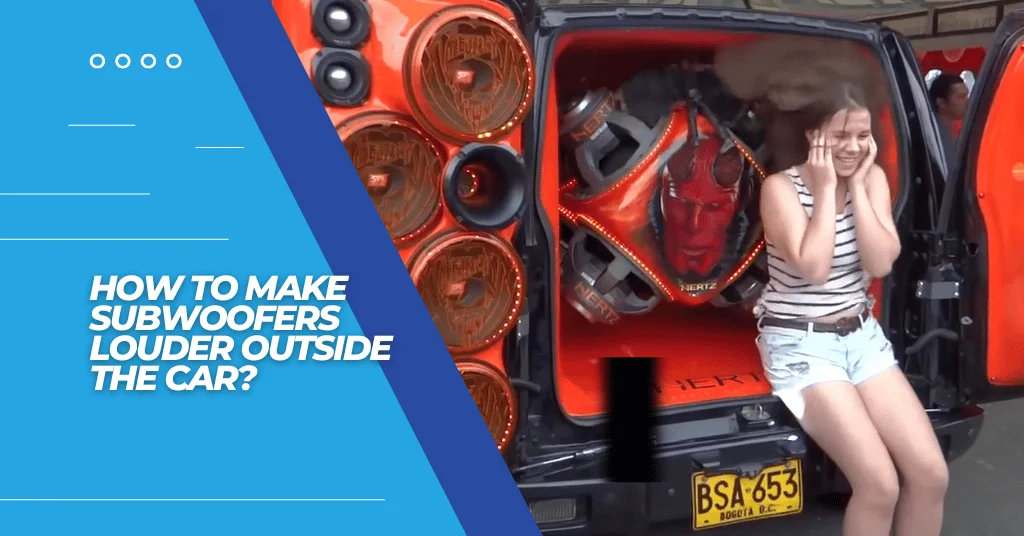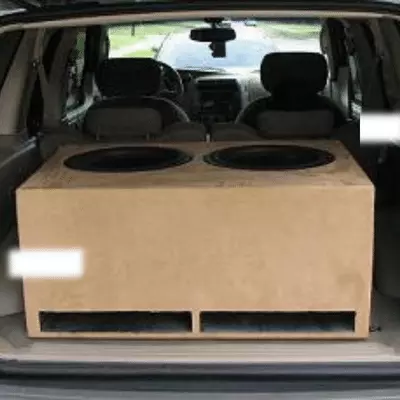How to Make Subwoofers Louder Outside the Car?

Are you a car audio enthusiast like me and want to make a bass impact outside your car? If you don’t know how to make subwoofers louder outside the car, you need to optimize your car sub correctly. I’m here to give you a helping hand and will guide you on correctly setting up or choosing the right subwoofer to get the job done.
However, subwoofers are made to produce low-level frequencies. You can easily make them loud by using a suitable amplifier or setting up the right eq setting. But more factors must be checked to hear your subwoofer’s sound louder outside the car.
What Are the Things That Make Car Subwoofers Sound Louder?
First and foremost, we should clarify that you have a qualified subwoofer before going further. Let’s have a look at the below points that make a car subwoofer loud:
Subwoofer’s Size:
A subwoofer’s size directly impacts its ability to produce a loud and clear sound. The larger the subwoofer, the more powerful and efficient it has audible bass tones. A large subwoofer has a larger cone area, which translates into more air movement. Additionally, more giant subs can move more air and thus produce louder fuller bass tones.
Moreover, larger subwoofers are better at accurately reproducing low frequencies than smaller models because they can generate them with greater clarity and accuracy. Furthermore, more giant subs can also handle higher power levels without becoming distorted or overdriven. As a result, an appropriately sized subwoofer can provide the user with a much richer and more robust sound than would be possible with a smaller sub.
Enclosure Type:
Enclosure type is essential in getting the most out of your subwoofer. Different enclosures can work to increase sound output, improve low-frequency response, reduce distortion, and more. The most basic type is a sealed box, which provides tight, accurate bass but generally will provide less output than other types.
Vented or ported boxes are designed significantly to increase the loudness of a subwoofer. These enclosures can move air in and out of the box, which helps produce deeper bass and higher sound pressure levels (SPL).
Sub’s Capability to Handle the Power:
A good subwoofer with high power-handling characteristics will be able to handle higher wattages and produce louder bass notes than a lower-rated model. As we all know, more power means more volume and better sound quality.
Vehicle’s Size:
Generally, larger vehicles have more room for a subwoofer. The larger the space available to install the subwoofer, the louder it can be. This is because two or more subs will fill a larger area with sound waves and create more outstanding SPL (Sound Pressure Level).
Subwoofer’s Position:
The positioning of a subwoofer in a car significantly impacts the loudness of the car’s sound system. The physical location and orientation of the sub can drastically affect the amount and quality of sound produced. For example, if you mount your sub in a corner, this may increase its power-handling and cause it to be louder than if the same subwoofer was mounted in the center of a car. Likewise, an enclosure directly behind the seat may produce more sound than one further away. Of course, the size and power of your sub will also affect its loudness.
Sensitivity:
The sensitivity of your car subwoofer can play a significant role in determining how loud it will be. Sensitivity refers to the efficiency of your subwoofer’s ability to convert power into sound energy. You can measure it in decibels (dB). A higher sensitivity rating means less power is required for the same volume level, while a lower sensitivity rating will require more power.
The sensitivity of your subwoofer can also affect the frequency response, affecting the bass’s quality. A higher sensitivity rating will provide a fuller, deeper bass sound, while a lower sensitivity rating may provide less bass output.
10 Ways to Make Subwoofers Louder Outside the Car:
Now that we know what things are responsible for louder bass. Now, let’s have a moment to make the sound louder outside the car.
1. Face Your Sub to the Hatch Behind the Seat:

When the subwoofer faces the hatch, instead of shooting sound outward, it reverberates off the back wall and amplifies the bass. Using this placement, you will get a much fuller and more resonant sound than an outward-facing subwoofer. Additionally, it means you don’t have to spend as much energy trying to power the sound outward and can focus more on ensuring that your low end is deep and powerful.
Furthermore, having your subwoofer facing the hatch makes it easier to adjust the audio levels for situations like cruising around town or thumping in the car’s club. So next time you take your sound system up a notch, make sure you face the subwoofer towards the hatch behind your car seat!
2. Use a Large-Sized Subwoofer:
Look, if you are someone who really wants to make a sound louder outside the car, then you will have to use a large-sized subwoofer. If you are using a smaller subwoofer, you may have weaker sound than the large ones. Don’t worry; you can still optimize your small car subwoofer for a better and loud sound. By installing a large-sized subwoofer into your car’s stereo system, you can create an immense amount of bass-heavy sound that vibrates far beyond the car’s interior.
When strategically placed in areas such as behind the back seat or underneath the seat, these powerful devices can produce a loud bass that will turn heads! To ensure maximum volume output, choose a subwoofer that is the right size for your car. Also, pair it with an amplifier to give it the power to create that deep, heavy sound outside your vehicle.
3. Lower the Car Windows:

Another easier way to quickly amaze the people outside your car is to lower your car’s windows. When you play music in your car, you may find that the sound is quiet outside the vehicle. This is because your car windows can act as a natural barrier, blocking some of the sound waves and making them less audible to those nearby.
Try lowering all four windows simultaneously to maximize the volume outside of your vehicle. Lowering the windows can make sound up to twenty decibels louder, allowing others to hear the music playing in your car.
4. Correctly Tune the Subwoofer:
Tuning your subwoofer correctly can significantly increase the volume of sound emanating from your vehicle. The first step in tuning up your subwoofer is selecting the correct size for your car; if you get one too large, it won’t provide enough power to increase the volume. Next, ensure that your subwoofer is securely mounted and connected to the power source and amplifier.
It would help if you located your subwoofer in an area where you can get the most sound out of it. For example, this could be in a corner or near an open window. In addition, ensuring that your subwoofer is appropriately sealed with weather-resistant material will also help to make the sound louder outside the car.
5. Use Multiple Subs at Once:

Look, let’s give it a try by using multiple car subwoofers at once. Why? Using multiple car subwoofers at the same time can significantly increase sound pressure outside of your car. Each subwoofer adds extra bass reinforcement to the audio signal, resulting in loud music and more powerful bass. Additionally, multiple subs can improve sound clarity by distributing the bass frequencies among multiple speakers instead of a single speaker.
This ensures you can clearly hear different frequencies, making the sound much more balanced. Furthermore, multiple subs in a car can create an immersive listening experience due to their wider dispersion of sound waves. Using various woofers together, you will hear a fuller range of bass notes and enjoy richer-sounding music overall.
6. Using Eq to Set Treble and Bass Frequency:
Equalizing (EQ) your sound system can significantly impact your music’s overall volume and clarity on the road. Consider adjusting the treble and bass frequencies with an EQ setting to get more volume out of your vehicle’s audio system. By correct settings, you will increase volume and help clarify each instrument or vocal track in your music.
When adjusting the treble and bass frequencies, start by boosting those ranges slightly. You don’t want to increase too much, or your sound may become distorted. Instead, find the setting that gives you the best balance between clarity and volume. Once you have adjusted the treble and bass frequencies, you can change other frequency ranges to refine your sound further. If the treble and bass are too loud, reduce those frequencies a little.
You may also want to experiment with boosting or reducing other frequency ranges, such as mid-range frequencies. Using an EQ to set the treble and bass frequencies, you can make your music sound louder outside the car without sacrificing clarity. With some experimenting, you can find the perfect balance between loudness and clarity that will get you noticed when you’re on the road.
7. Use a Well-Designed Ported Box:

Why not replace your poor-design woofer box with a well-designed ported box? Using a well-designed ported box is one of the easiest and most efficient ways to make the sound louder outside the car. The fundamental goal when designing a ported box is to create an acoustic “enclosure” that can efficiently transfer sound energy from inside the vehicle to the outside environment.
A ported box allows air to flow in and out of the enclosure, creating a pressurized environment capable of producing increased sound levels. This pressure helps to magnify the sound energy as it travels outside your vehicle, allowing you to achieve loud music and more precise results. Ported boxes can produce loud and powerful sounds in a much smaller package than traditional sealed boxes when designed correctly.
That’s because the ported box can increase the efficiency of sound energy transfer, allowing more sound to escape from the vehicle without sacrificing power or volume. As a result, these boxes can provide an impressive audio experience in any environment and are ideal for those who want their music to be heard louder outside the car.
8. Use a Compatible Amp to Power the Sub:
It could be possible that you are using a powerful subwoofer with a weaker amplifier. That’s why you need clarification about having weaker sounds. Let’s replace it with a compatible amplifier. Why? As discussed above, the amp provides the following:
- Increase wattage
- Allow more energy to be put into the sub.
- Making a sub produce a higher output than an unamplified system or weaker amp
Installing compatible external amplifiers gives you more control over equalization and gain so you can fine-tune the sound to your needs. When paired with a compatible subwoofer and enclosure, a compatible amplifier can help make your music louder, more impactful, and better sounding than ever before.
With this combination of components, you can quickly fill any space with powerful bass that moves even the most discerning audiophile. So if you’re looking to turn up the volume outside your vehicle, consider using a compatible amplifier to power your subwoofer for maximum sound quality and performance.
9. Use Double Magnet Subs:
If you have a single-magnet subwoofer, replace it with double magnets. This way, you can quickly improve the sound of the car stereo system. The double-magnet subwoofer uses two magnets instead of one. These dual magnets allow the subwoofer to produce higher sound pressure levels (SPL), making the sound louder and more powerful when heard from outside the vehicle.
The dual magnets also help fine-tune the frequency response, creating a clearer and tighter bass sound. The double-magnet subwoofer also has a higher sensitivity rating, which can help amplify the sound and make it more powerful when heard from outside the vehicle.
Compared to single-magnet subwoofers, double-magnet subwoofers can produce louder and better-sounding bass notes due to their improved design. This makes them the ideal choice for listeners looking to make the sound of their car’s audio system louder and more powerful when heard from outside the vehicle.
10. Connect a Right Capacitor With the Sub:
It sounds impossible. But believe me, connecting a right-sized capacitor with your sub can improve your vehicle’s stereo sound. A subwoofer can provide extra sound and bass to your car music system, but its power needs to be managed. A capacitor is a device that helps regulate the amount of energy delivered to the subwoofer. Connecting the suitable capacitor increases the loudness of your subwoofer, both inside and outside your vehicle. You can watch how a capacitor can help improve sound on youtube ⁽¹⁾.
The most important aspect of a capacitor is its Farad rating, which indicates how much power the capacitor can store. The higher the Farrad rating, the more power it can store and deliver to your subwoofer. An underpowered capacitor will not be able to store enough power, resulting in reduced bass response and volume.
When selecting a capacitor, choosing one with the correct Farrad rating for your subwoofer is essential. Once you have connected the suitable capacitor, you’ll notice an immediate increase in sound levels outside your vehicle. This is because the capacitor helps to ensure that your subwoofer receives enough power for maximum volume.
Additionally, a capacitor can help reduce the strain on your car battery and electrical system, allowing you to enjoy more powerful audio without risking damage.
Avoid These Three Mistakes That Can Kill Your Car Subwoofer’s Bass:
However, most of my friends complained about having a terrible car sound system. When I checked their car sound system, they made many mistakes regarding setting up their subwoofers. Their top three mistakes were:
1. Wrong Polarity:
Most of them were beginners, so they didn’t know how setting up the wrong wiring could kill the car stereo system. Why? When wiring a car subwoofer, it’s essential to ensure the positive and negative terminals are wired correctly.
One of the most common mistakes is setting up the wrong polarity – when you connect the amplifier’s positive terminal to the subwoofer’s negative terminal or vice versa. If you make such a mistake, your subwoofer will be unable to move any air and, therefore, won’t produce any bass.
Furthermore, incorrect polarity can cause your subwoofer to overheat. This is because the speaker is trying to move against its natural flow of electricity, which means it has to expend more energy than usual. The extra heat generated by this process can damage the subwoofer, eventually causing it to burn out.
To avoid these issues and ensure your car’s subwoofer bass is always booming, verify that the polarity between the amplifier and subwoofer terminals match before you start wiring your system. This simple step can save you a lot of time and money in the long run. Good luck!
2. Using the Wrong Subwoofer Box:
No doubt they were using a powerful subwoofer and amplifier. But they made a mistake by having a subwoofer mounted in the wrong woofer box.
As I have discussed above, the wrong-sized or wrong-designed sub-box can significantly impact your overall sound system. The wrong subwoofer box can be a big problem for your car’s sound system. If the box is too large, it could overwork your amplifier and cause damage to the speakers and other components.
Conversely, if the box is too small, you may not get the best sound out of your expensive subwoofers. In addition, the wrong enclosure can prevent your subwoofer from performing at its peak and limit the sound quality.
3. Using A Wrong-Sized Amp:
Another mistake I found in their car audio system was connecting a wrong-sized amplifier with their subwoofers. If you use an amp with too much power, you risk overdriving and potentially damaging your speaker. On the other hand, if you don’t provide enough power, your speaker won’t reach its full potential.
How to Position Sub in the Trunk?
Installing a subwoofer in the trunk of your car can be an effective way to create powerful and dynamic sound. However, proper positioning in the car trunk is key to ensuring maximum performance. Here’s how to properly position your subwoofer in the trunk:
- Determine the size of your sub.
- Place your sub in the center of the trunk.
- Route your power cable away from other wires.
General FAQs
How Can I Make My Car Sub Louder?
You can quickly make your subwoofer louder by upgrading your amplifier to a compatible one, adding the suitable capacitor, switching to a ported enclosure, place it in the right spot. However, you should never keep the volume too high as it can damage your car subwoofer.
What Makes a Subwoofer Loud?
When a subwoofer thumps, it makes air molecules move back & forth. The more the air molecules vibrate, the more the subwoofer will produce a loud sound.
Will a Bigger Box Make Subs Louder?
The size of the subwoofer can impact its volume, but it’s not directly proportional to the subwoofer box size. However, using a larger enclosure will give you some positive points, but if the subwoofer size is small and the box size is large, you may not get an excellent loud sound.
